Altering Source of Organic Trace Minerals Improves Milk Fat in Commercial Dairy- Juniper Publishers
Journal of Dairy & Veterinary Sciences- Juniper Publishers
Abstract
Little research is available directly comparing
organic trace mineral sources. Therefore, the objective of this study
was to determine effects of altering source of organic trace minerals on
lactation and reproductive performance in a commercial dairy herd. Six
pens (3 per treatment) received isomineral diets, differing only in
supplemental Cu, Mn, and Zn source for 7 months. Supplemental Cu, Mn,
and Zn were provided as metal methionine hydroxy analog chelate (MMHAC)
or metal complexes of methionine and lysine (MMKC). Monthly milk yield,
composition, and reproduction information were collected and analyzed
using SAS/STAT software (Version 9.3; SAS Institute Inc., Cary, NC) with
repeated measures as appropriate. No significant effects of treatment
were observed for reproductive parameters including conception risk at
any breeding (29.9 versus 29.4 %; 95% CI 17.0, 47.0, MMKC and MMHAC
respectively) and days open (106.8 vs. 107.8; 95% CI 99.9, 114.2).
However, a significant treatment by time interaction was observed for
milk yield (40.0 versus 39.8 ± 4.1, MMKC and MMHAC respectively; P =
0.02), percent fat (3.45 versus 3.51 ± 0.20; P < 0.01), and percent
solids non-fat (8.77 versus 8.80 ± 0.10; P = 0.04). Observed increases
in milk fat (12.4 g) suggest additional value for MMHAC because of
methionine hydroxy analog ligand. Together this data suggests that
differing source of organic trace mineral changes lactation performance,
particularly milk fat, over time that may significantly impact dairy
farm revenue.
Keywords: Organic trace minerals; Dairy; Performance; Milk fat
Abbreviations:
ITM: Inorganic Trace Mineral; MMHAC: Metal Methionine Hydroxy Analog
Chelates; MMKC: Metal Methionine and Lysine Complexes; OTM: Organic
Trace Mineral
Introduction
Trace minerals such as Zn, Cu, and Mn are essential
for health and performance of production animals. Historically, Zn, Cu
and Mn have been supplemented using inorganic salts [1]; however, due to
the slightly acidic environment in the rumen, inorganic salts tend to
dissociate, increasing interactions with antagonists and reducing
absorption [2]. Supplementing trace minerals in organic forms reduces
dissociation of the trace mineral in the rumen environment due to the
organic ligand(s) bound to the mineral, resulting in increased
absorption [3,4].
Previous research investigating the effects of metal
complexes of methionine and lysine have shown that both mineral sources
have greater bioavailability compared to inorganic salts [5,6].
Furthermore, supplementing metal complexes of methionine and lysine has
increased milk production and reduced SCC compared to inorganic trace
mineral (ITM) supplementation [7-9]. Research in which metal methionine
hydroxy analog chelates were supplemented support increased milk yield
[10,11], immune function [11,12], and hoof health [11,13]. These
responses suggest greater absorption and availability to the animal for
metal methionine hydroxy analog chelates compared to inorganic forms
[14,15]. With greater availability of organic trace minerals (OTM),
regardless of the ligand, increases in lactation performance support
organic trace mineral use over ITM use.
Little research has compared the effect of altering
the source of OTM. Research looking at the impact of trace mineral
supplementation in broilers, observed decreases in plasma lipid
hydroperoxide, an indicator of oxidative stress, and increases in
intestinal breaking strength with metal methionine hydroxy analog
chelates compared to amino acid complexes [1]. Furthermore,
metallothionine expression increases with supplementation of metal
methionine hydroxy analog chelates compared to amino acid complexes and
proteinates in broilers [16]. Together these data support a benefit to
supplementation with chelated minerals over other OTM in broilers and
highlights the need for comparisons of OTMs in ruminants.
When comparing performance and liver mineral levels
of cows supplemented amino acid complexes or metal methionine hydroxy
analog chelates, liver copper, as well as milk manganese and fat, were
increased with metal methionine hydroxy analog chelates. With the more
complex digestive system of ruminants, additional research is needed to
verify the benefit of metal methionine hydroxy analog chelates over
other OTM.
Therefore, the objective of this trial was to evaluate the effects
of supplementation with two sources of OTM on lactation and
reproductive performance, as well as lameness, in a commercial
dairy herd.
Materials and Methods
Study design and treatments
This study occurred over 7 months and served as a prospective
split herd side-by-side comparison-controlled trial. A total of 6
pens of lactating cows from a commercial dairy in California were
enrolled in the study. All pens received the same isomineral diets
during the study period with the difference of the organic source
of Zn, Cu and Mn. Three pens were supplied metal methionine
hydroxy analog chelate (MMHAC) as a source of supplemental
Zn, Cu, and Mn (MINTREX®, Novus International, St Charles,
MO). The other three pens were supplied metal complexes of
methionine and lysine (MMKC) as a source of supplemental Zn,
Cu, and Mn (4-PLEX®C, MANPRO 160 and ZINPRO 120, Zinpro
Corporation, Eden Prairie, MN). As MMKC provided cobalt
glucoheptonate, cobalt glucoheptonate was added at the same
inclusion level to MMHAC.
Animal management
A total of 3,575 cows were enrolled in the study across a total
of 6 pens over the 7-month experiment. Cows of similar days in
milk and production were housed together, when feasible, to
allow for a similar average lactation number and days in milk
for both treatment groups. Pen inventory was reviewed biweekly
to ensure cow movements between pens-maintained treatment
assignment over the duration of the study. For the duration of the
study, animals were cared for according to standard site practices
and cows deemed to require veterinary attention or treatment
outside of veterinary care (i.e. mastitis etc.) were handled
according to established site standard operating procedures.
These practices and procedures agreed with principles presented
in Guide for the Care and Use of Agricultural Animals in Research
and Testing.
Diets and feed preparation
Diets were formulated to be isomineral and differed only in
the source of organic Zn, Cu, and Mn (Table 1). Mineral premixes
containing the different sources of OTM were prepared in larger
batches at a commercial feed mill. Feedstuffs were combined
daily and cows were feed a TMR twice daily. Premixes and TMR
were sampled once a month during the study period (n=7) [17]
and analyzed for nutrient and mineral composition using AOAC
International (2000, 2006) approved methods at a commercial
laboratory (Cumberland Valley Analytical Services, Hagerstown,
MD).
Animal Measures and Data Management
Animal records (monthly DHIA lactation performance,
reproduction, and culling) to encompass the 7 months of the trial
were collected from the farm’s record system (Dairy Comp 305;
Valley Agricultural Software, Tulare, CA). Cows were followed
until the end of the study period, end of current lactation,
movement to another non-study pen (i.e. low production)
or removed from the herd based on whichever comes first.
Lactation performance measures included milk yield, fat, solids
non-fat, and SCC. Milk SCC was log transformed to normalize
the data to linear SCC. Additionally, SCC was categorized by
level of SCC into 1 of 9 categories (1 = 0 to 125,000cells/mL; 2 =
125,001 to 250,000cells/mL; 3 = 250,001 to 375,000cells/mL; 4
= 375,001 to 500,000cells/mL; 5 = 500,001 to 625,000cells/mL;
6 = 625,001 to 750,000cells/mL; 7 = 750,001 to 875,000cells/
mL; 8 = 875,001 to 1,000,000cells/mL; and 9 = > 1,000,001cells/
mL) to allow for analysis of differences in distribution between
category.
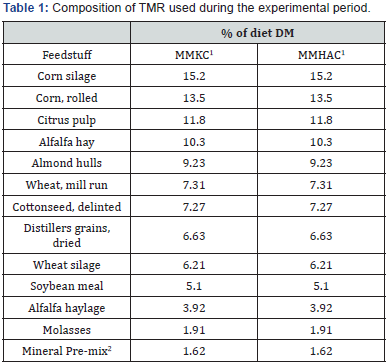
2MMKC mineral pre-mix contained 42.5% calcium carbonate, 33.4% sodium bicarbonate, 7.09% magnesium oxide, 6.41% rice bran, 4.92 % vitamin and trace mineral pre-mix, 2.82% yeast culture, 1.43% metal methionine and lysine complexes, 1.01% fat blend, 0.22% biotin (2%), and 0.20% agolin. MMHAC mineral pre-mix contained 43.1% calcium carbonate, 33.4% sodium bicarbonate, 7.08% magnesium oxide, 6.40% rice bran, 4.92 % vitamin and trace mineral pre-mix, 2.82% yeast culture, 1.01% fat blend, 0.46% zinc methionine hydroxy analog chelate, 0.31% manganese methionine hydroxy analog chelate, 0.22% biotin (2%), 0.20% agolin, 0.02% zinc methionine hydroxy analog chelate, and 0.02% cobalt glucoheptonate.
The percent of animals in each pen was calculated for
each
category for later analysis. Milk production and composition
analysis were limited to observations collected from 60 to 500
DIM to remain within the linear portion of the lactation curve.
For reproduction, date of first breeding, date of conception, and
pregnancy result were used only from cows housed in study
pens at the time of first breeding to determine risk and days to
conception. For cows with more than one conception recorded
(e.g. due to embryo loss/abortion), the 1st conception date was used
(after examination of the individual records for validation).
Reproduction parameters were calculated for cows between 60
to 500 DIM and those bred for the first and subsequent times
during the study period within their assigned pen. Lameness
and lying time were assessed every 2 months (n=3) using the
methods of Flower & Weary & Ito [18,19] respectively. Lameness
was defined as cows scoring greater or equal to 3, while severe
lameness was defined as cows scoring greater or equal to 4.
Stocking density was also recorded at each assessment. For
all cows in the study, the removal date (culling or death) was
retrieved to determine risk and days to culling.
As this study was conducted allowing for natural movement
of cows within a farm, to maintain independence between
experimental units (pens) only observations collected within
one pen were utilized for cows listed in multiple pens over the
study period. As such, the number of milk production records
for each cow within each pen was calculated. Each cow was
assigned to the pen with the max number of observations and
only observations within the assigned pen were included into
the analysis. In case of ties, the pen where the cow was in first
was considered. For single events (e.g. conception and culling
risk) only events observed in the assigned pen were considered
unless otherwise specified.
Statistical analysis
In the current study, treatments were randomized to pens;
therefore, the experimental unit was pen (6 pens in total with 3
pens per treatment) and cows within pen constituted sampling
units. Data were analyzed using the SAS/STAT software (Version
9.3; SAS Institute Inc., Cary, NC). Milk production data were
analyzed using the mixed procedure with repeated measure
analysis where the time variable consisted of days post-trial
initiation. The repeated measure model included treatment,
time and their interaction as fixed effects. Pen within treatment
was included in the model as a random effect. Cow within
treatment was the subject of the repeated statement and
compound symmetry was used as the covariance structure. To
evaluate differences in distribution of SCC between treatments,
a Kolmogorov-Smirnov test was preformed using NPAR1WAY
procedure. Conception and culling risk, number of breeding times
and days open were analyzed using the GLIMMIX procedure.
Distributions implemented were Binomial, Poisson and log-
Normal for conception and culling risk, breeding count and days
open, respectively. Pen within treatment was included in the
model as a random effect. The effect of treatment on survival
time (time to conceive, time to die, or being sold) was modelled
using the Cox proportional hazards regression using the PHREG
procedure available within SAS/STAT software using a robust
sandwich estimator and accounting for the intra-pen dependence.
The repeated measure model included treatment, time and their
interaction as fixed effects, pen within treatment was included in
the model as a random effect, and cow within treatment as the
subject of the repeated statement with a compound symmetry
covariance structure. Significance was declared at P < 0.05 and
tendency was declared at 0.05 ≤ P < 0.10.
Results and Discussion
Lactation performance
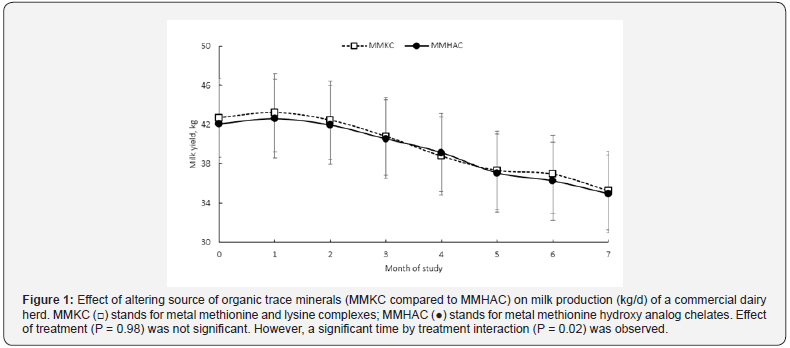
Analyzed nutrient composition of the treatment rations
agreed with calculated composition (Table 2) and were in close
approximation to one another. Milk yield (P = 0.98) and fat
corrected milk (P = 0.99) were not significantly altered by OTM
source (Table 3). When the interaction of treatment and time was
evaluated, a significant interaction was observed for milk yield
(P = 0.02, Figure 1) with milk yield being greater (0.37 kg/d) for
MMKC over time. Previous research comparing supplementation
with ITM to those with MMHAC also observed no differences in
milk yield. However, a meta-analysis suggested an increase in milk yield by 0.93 kg/d when trace minerals are supplemented as
amino acid complexes compared to ITM. These changes in milk
volume may be linked to changes in milk components observed
in this trial.
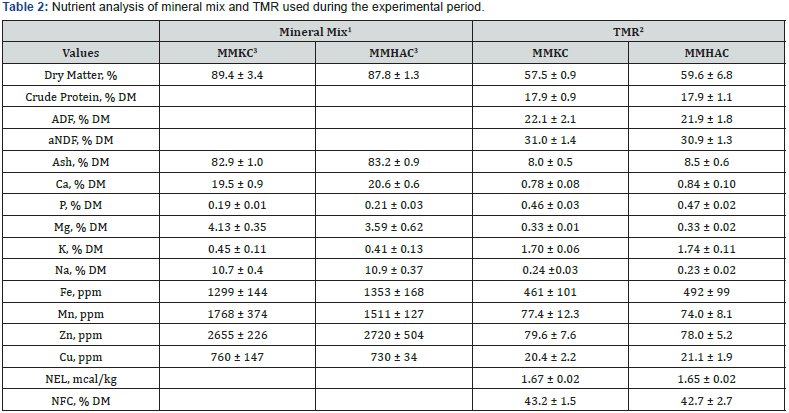
2n = 7 samples/treatment; values presented are means with associated standard deviation.
3Treatments include metal methionine and lysine complexes (MMKC) and metal methionine hydroxy analog chelates (MMHAC).
Altering source of OTM did not change milk fat percent (P
= 0.88) and solids non-fat percent (P = 0.78); however, both
parameters were significantly altered (P < 0.01) by time (Table
3). This resulted in significant interaction between treatment and
time for milk fat percent (P < 0.01; Figure 2) and solids non-fat
percent (P = 0.04; Figure 3). In fact, when combining reduction
in milk yield with increases in milk fat percent observed with
MMHAC, there is still a benefit of MMHAC to have greater milk fat
yield by 12.4 g per day (1366.8 g of milk fat for MMKC and 1379.2g
of milk fat for MMHAC). This increase suggests that changes in
milk yield were most likely due to altered nutrient partitioning
to support greater milk fat synthesis with MMHAC over time.
Previous research with amino acid complexes, including MMKC,
observed increases in fat yield when compared to ITM [20]. Other
research observed increased milk fat with feeding of MMHAC
ligand [21,22], suggesting there is ample research to support
increasing milk fat with MMHAC supplementation.
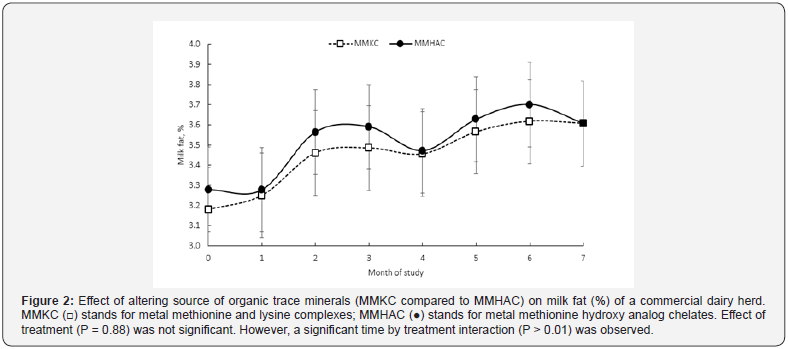
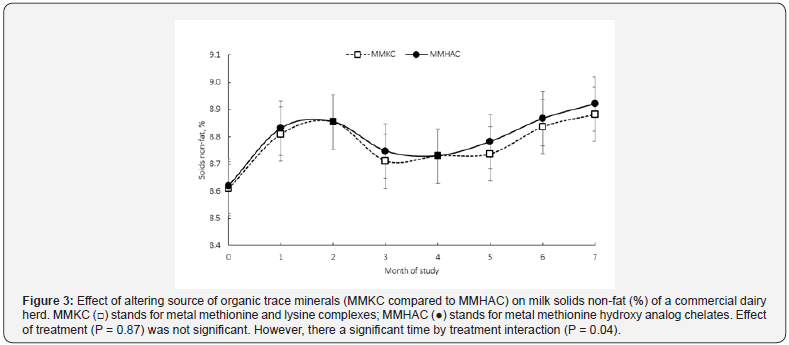
This observed increase in milk fat may be multi-faceted
as recent research shows a role for 2-hydroxy-4-(methylthio)
butanoate to modify biohydrogenation pathways in the rumen
in favor of increasing milk fat [23-25]. Moreover, a recent metaanalysis
supports the benefits of supplementing 2-hydroxy-4-
(methylthio) butanoate, the ligand associated with MMHAC, to
increase milk fat yield by 45g/d [26]. Together this data supports
that there is additional value to the methionine hydroxy analog
ligand associated with MMHAC supplementation than the lysine
and methionine ligands associated with MMKC supplementation.

2n = 3,575.

Somatic cell score did not differ between OTM source (P =
0.97) nor was there a significant interaction of treatment and
time (P = 0.14; Table 3). When the level category of SCC was
considered, no differences were observed in the percent of
animals in each category of SCC level between treatments (P ≥
0.48; Table 4). Furthermore, there was no observed difference
in the distribution of SCC levels between treatments (P = 0.70;
data not shown). Previous reports on the effect of trace minerals
on SCC have varied. Comparison of ITM to amino acid complexes
resulted in a significant decrease (54%) in SCC. Conversely, trials
comparing use of amino acid complexes, as well as metal chelates
of methionine hydroxy analog, have observed no differences in
SCC [27]. Previous research suggests that the ability of OTM,
such as Zn, to reduce SCC depends upon initial SCC being high
[28]. With 84.6% (MMKC) and 84.3% (MMHAC) of cows having a
SCC less than 250,000 cells/mL, there was most likely not a role
for Zn and other OTMs to improve SCC. Lack of changes between
the treatment groups of the current trial may suggest that udder
health was optimized for the herd used in this trial, limiting the
ability of trace minerals to reduce SCC.
Reproductive Performance
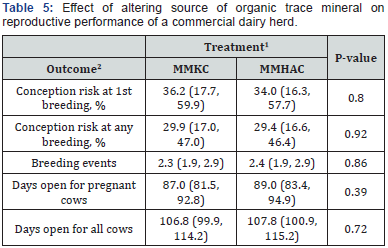
2Analysis includes cows bred only during the study period and n = 1,799; data presented as means with associated 95% confidence interval.
No significant treatment effects were observed in any of the
reproduction parameters assessed (Table 5). Conception risk (P
≥ 0.80), days open (P ≥ 0.39), and number of breeding events (P =
0.86) did not differ between treatments. First service conception
risk (36.2% for MMKC and 34.0% for MMHAC) and overall
conception risk (29.9% for MMKC and 29.4% for MMHAC) were
high compared to other herds in California. Previous research
reported first service conception risk of 30.8% and an overall
conception rate of 26.4 % in a large Central Valley dairy [29],
while Cassell & McAllister [30] reported a 22% first service
conception rate for Holstein dairy cows in California. Together
these number suggest that the herd used for the current trial had
maximized reproductive function due to conception rates being
greater than other reported values for large herds in California.
With reproductive function optimized in this study, and
the integral roles Cu, Zn, and Mn play in reproductive function,
treatment means suggest that the maximized reproductive
function of this herd limits the sensitivity of reproductive
performance to be an indicator of bioavailability of the high
quality OTM evaluated. In fact, most reported changes in
reproductive performance are observed under deficiency
conditions or with large differences in quality of trace mineral.
When MMHAC completely replaced ITM in a 305-d lactation
trial, cows supplemented MMHAC had greater odds of conceiving
at earlier services [31]. Furthermore, in a commercial dairy
trial where MMHAC partially replaced ITM, conception rate
at first and second service were significantly greater for cows
supplemented MMHAC for at least 30 d. A meta-analysis for
MMKC supplementation in dairy cows supports a 13.5-day
reduction in days open and fewer services per conception when
compared to ITM supplementation. Together these data suggest
that both OTM sources provide the required level of mineral to
maintain reproductive performance, while suggesting that less
drastic changes in bioavailability of high quality OTM are not
reflected in situations, like the herd used for the current study,
where reproductive function is maximized.
Lameness

2As determined by Novus C.O.W.S. assessments; values represent cows scoring 3 or greater using methods of Flower and Weary (2006).
3As determined by Novus C.O.W.S. assessments; values represent cows scoring 4 or greater using methods of Flower and Weary (2006).
4n = 3,684; data presented as mean with associated 95% confidence interval.
No significant treatment effects were observed for lameness
(P = 0.57), severe lameness (P = 0.22), or culling risk (P = 0.67;
Table 6). Lameness was significantly altered by time (P = 0.01),
while severe lameness was not altered by time (P = 0.39). The
interaction between treatment and time was not significant
for lameness (P = 0.84) or severe lameness (P = 0.55). With
lameness being a multifactorial issue, lying time and stocking
density were measured at the same time lameness was assessed.
Altering source of OTM did not alter lying time (P = 0.80) nor did
stocking density differ (P = 0.73) between treatments. Lameness
prevalence varies by region, with a reported average of 30%
in California dairies, and severe lameness being lower, with an
average of 2% in California [32]. Comparing reported averages of
lameness to those observed in the current trial (less than 11%)
suggests that management was optimal for hoof health in this
herd.
Furthermore, failure to see differences between the two
treatments suggests both sources provided adequate mineral
nutrition allowing for structural integrity to be maximized.
This maximization makes lameness an insensitive marker for
differences in bioavailability of the high-quality trace mineral
sources utilized in the current study. Previous research suggests
Cu and Zn are imperative for hoof formation, with the hard
keratin found in hooves having greater concentrations of the two minerals than soft keratin located in other tissues [33].
Work comparing MMHAC inclusion to that of ITM inclusion in
dairy rations support a benefit of greater quality minerals to
reduce lameness over time, while MMKC has been shown to
reduce heel erosion compared to ITM [34]. Together, these data
indicate that cows were supplied the needed trace minerals from
both treatments to maintain a high level of structural integrity
resulting in low levels of lameness and severe lameness [35-37].
Implications
Reproductive Wastage
Reproductive wastage is normally considered to cover all
losses from mating to the first breeding of the offspring or death
of a foetus, calf or cow between confirmed pregnancy diagnosis
and weaning, and calculated as a percentage of pregnant cows.
Reproductive wastage is caused by environmental, genetic,
disease and management factors which operate with different
severities and in different combinations. These factors interfere
with ovulation, fertilization or implantation and during gestation
and parturition. According to Amuanmuta reported for Fogera
cattle, the overall mortality rate of 4.9 ± 1.3, 6.8 ± 1.4, 7.3 ± 1.7
and 10.1 ± 2.0 at the end of 30 days (neonatal period) 180, 240
(pre-weaning) and 360 days, respectively. Of the 640 total female
cattle reproductive tracts examined in Sululta slaughterhouse,
28.9% uterus are found pregnant, 66.6% (426) are cyclic ovarian
activities. Of the cycling cows, 7.5% are pregnants. 65.4% of the
fetuses are at early (< 3 months), 30.3% are mid (3-6 months)
and the rest 4.3% are at late (6 months) ages of pregnancies
[42]. Also, the total number of pregnant cows slaughtered during
the Hawassa municipality abattoir and Tula slaughter house is
92. Of the total pregnancies, 45.65% are found with early (first
trimester), 30.43% are mid (second trimesters) and 23.91%
are late stages (third trimesters). It is also found that the right
ovaries have the highest physiological activities than the left
ovaries and their percentage are 65.45% and 34.55% on the
right and left, respectively [43].
Reproductive health problem
The high level of reproductive performance and udder health,
as well as low prevalence of lameness made it difficult to detect
differences between MMHAC and MMKC in this 7-month trial.
This suggests that when these parameters are optimized, they
are not suitable indicators of bioavailability differences between
high quality OTM. However, an additional benefit is realized with
MMHAC due to improvements in milk fat. This increase in milk
fat speaks to the methionine analog component of the product,
as well as the rumen effect, of the HMTBa ligand associated with
MMHAC. This suggests that when MMHAC is provided, cows
realize not only the value of the mineral, but also a biological
value for the associated ligand. Finally, the significant increase in
milk fat due to MMHAC translates to a meaningful improvement
in profit in today’s dairy farms, even with the small increase in
milk yield from MMKC.
To know more about journal of veterinary science impact factor: https://juniperpublishers.com/jdvs/index.php
To know more about Open Access journals Publishers: Juniper Publishers




Comments
Post a Comment